We’ve painted kitchen cabinets before. We’ve done Ikea kitchen cabinets before. But painting Ikea kitchen cabinets was a new combo move for us. And despite a nagging voice in our heads that asked if it was a bad idea (paint laminate? or slick factory finished cabinets?! can that even be durable?! ), we’re extremely happy with the final result. Plus, it was pretty easy to do – no paint sprayer or fancy equipment necessary!
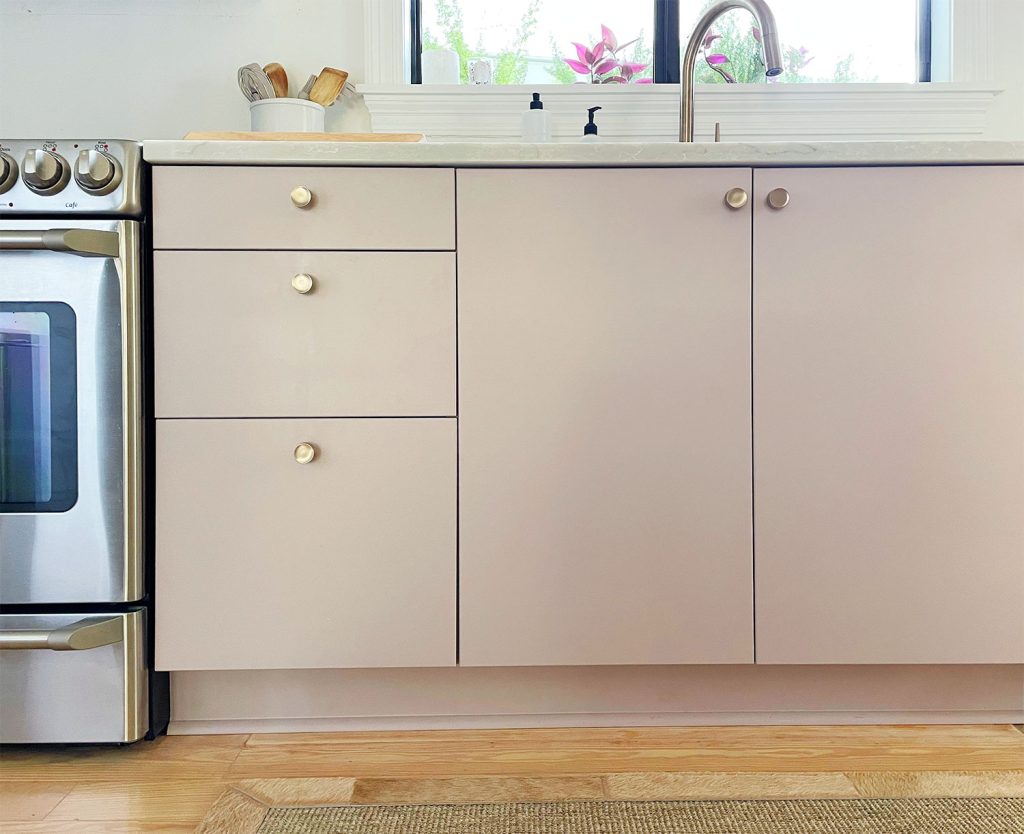
We’re about a month into using them every day and so far they’re holding up wonderfully. They’ve been scratched, scrubbed, kicked, and real-life tested by two kids and so far no scrapes, dings, or dents to report. They look as good as the day we freshly painted them, and as smooth as factory-made Ikea cabinets – so we’ll share how we got such even coverage.
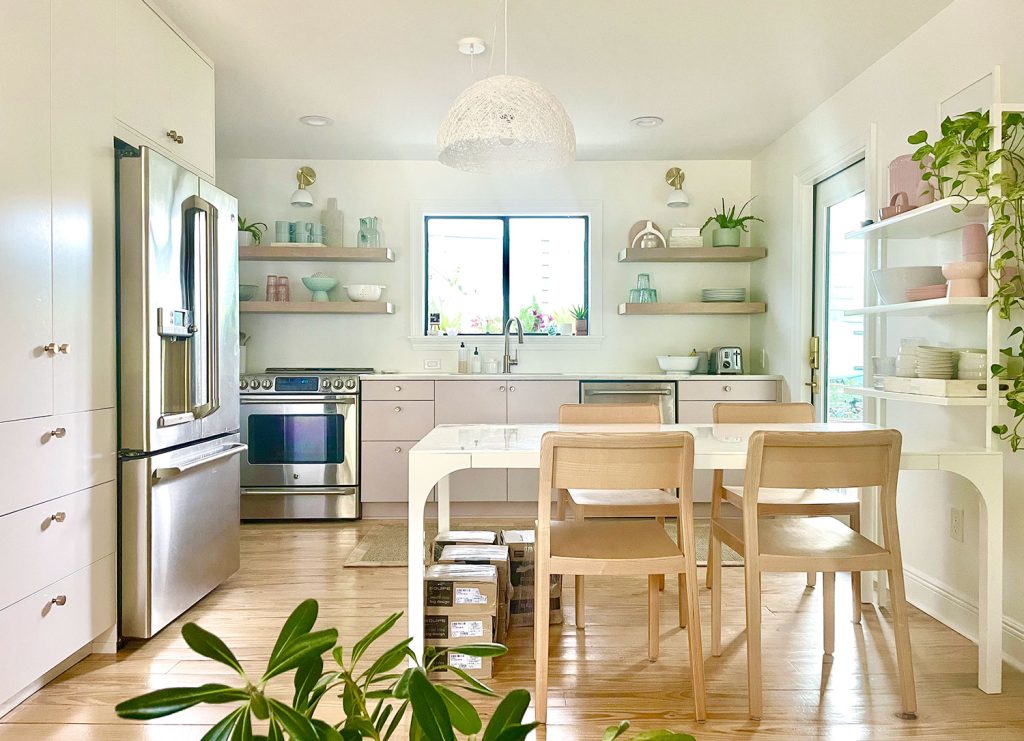
Before I show you the step-by-step instructions, let me give you some context for the project.
Why Did We Redo Our Kitchen With Ikea Cabinets?
As we discussed in our last podcast, we wanted to replace our old kitchen cabinets to better maximize the storage along that back wall. It’s a small kitchen and, although we’d organized it carefully enough to make it work for the past two years, we knew there was room for improvement.
The skinny drawer pictured below is a great example of how inefficient the old thickly-framed cabinets were. There was so much wood framing around the drawers & doors that everything was more cramped than it needed to be. What do you even put in a drawer that’s one olive oil bottle wide?
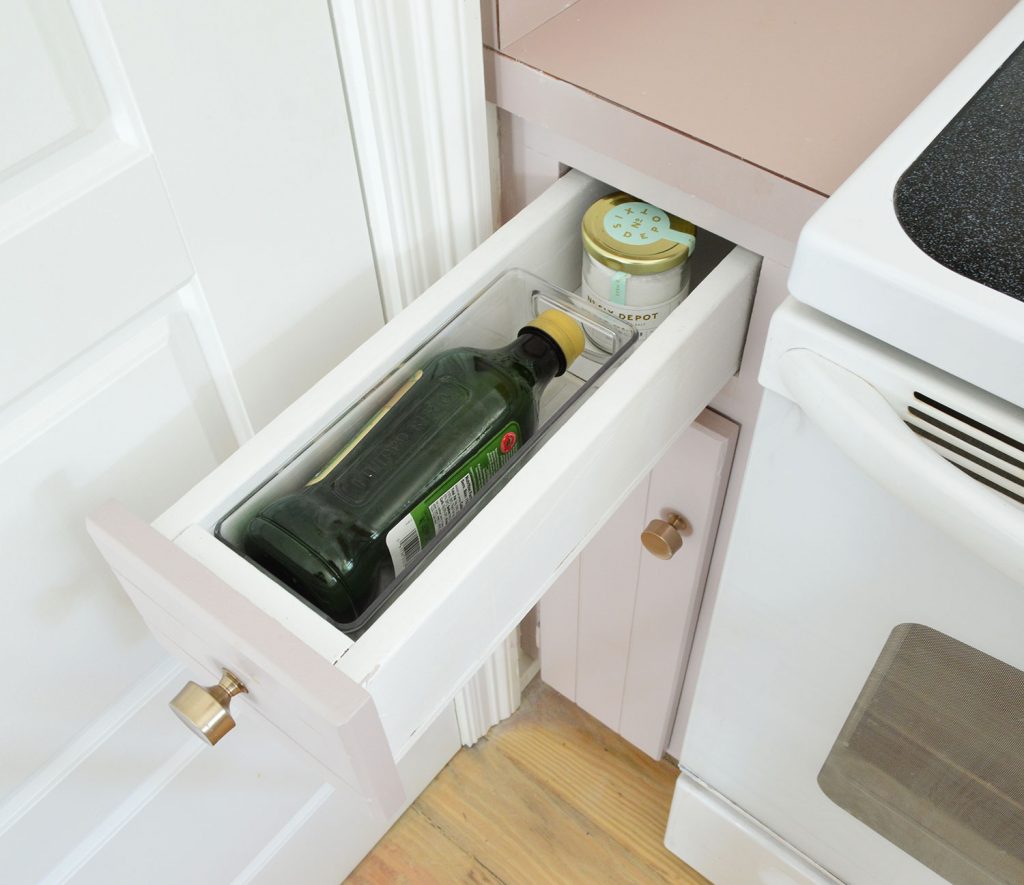
Yes, that’s the same sized olive oil bottle in the photo below, except now it can stand up because the drawer is much deeper along with being significantly wider, so we can store a lot more. We knew from our previous experience with Ikea kitchens (like at our beach house) that we could get big functional gains by replacing the cabinets. For one, there’s much less thick framing around the sides of Ikea cabinets- as you can see below – plus we shifted the stove over a bit, so this drawer ended up being much more useful for us.
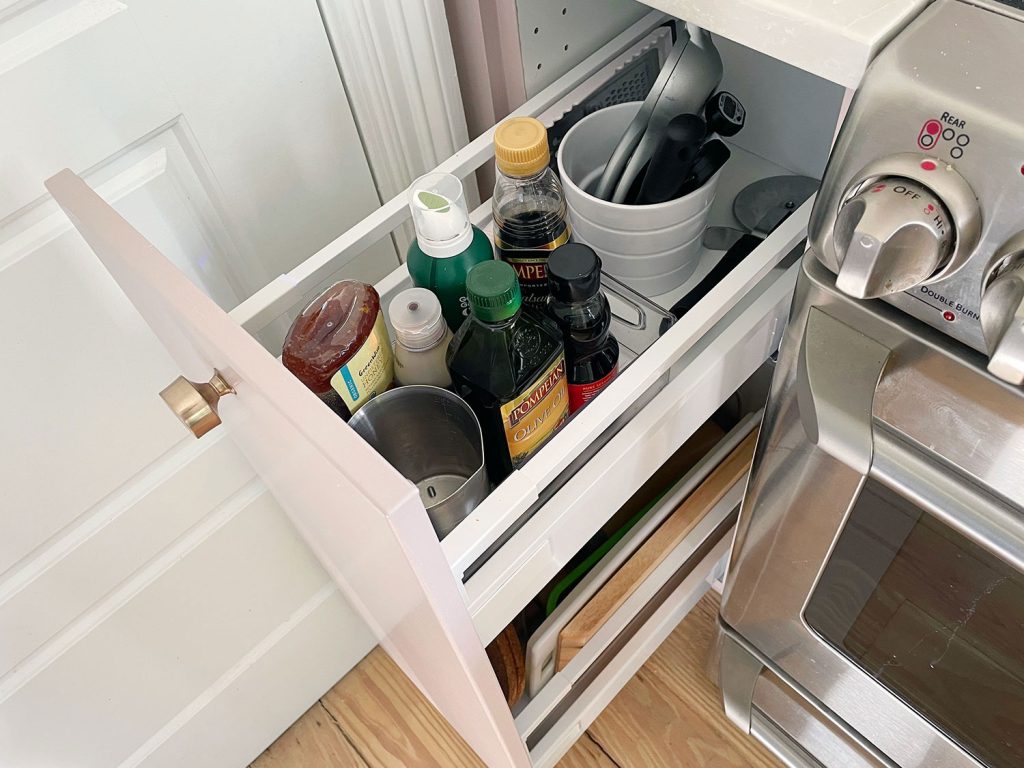
Not to mention that Ikea cabinets have so many customizable systems you can add (secret drawers that nest within other drawers, caddies that fit perfectly to corral things, etc). I’d say we upped our small kitchen’s efficiency by at least 50% by upgrading the cabinets. We’ll show you more about how we organized them in a future post. For now, back to the subject at hand: how we went from “Ikea white” to a custom paint color of our choosing.
Why Paint The Ikea Cabinets?
We REALLY loved the mauve color we painted the old cabinets (Artsy Pink by Sherwin-Williams). These are the old cabinets below:
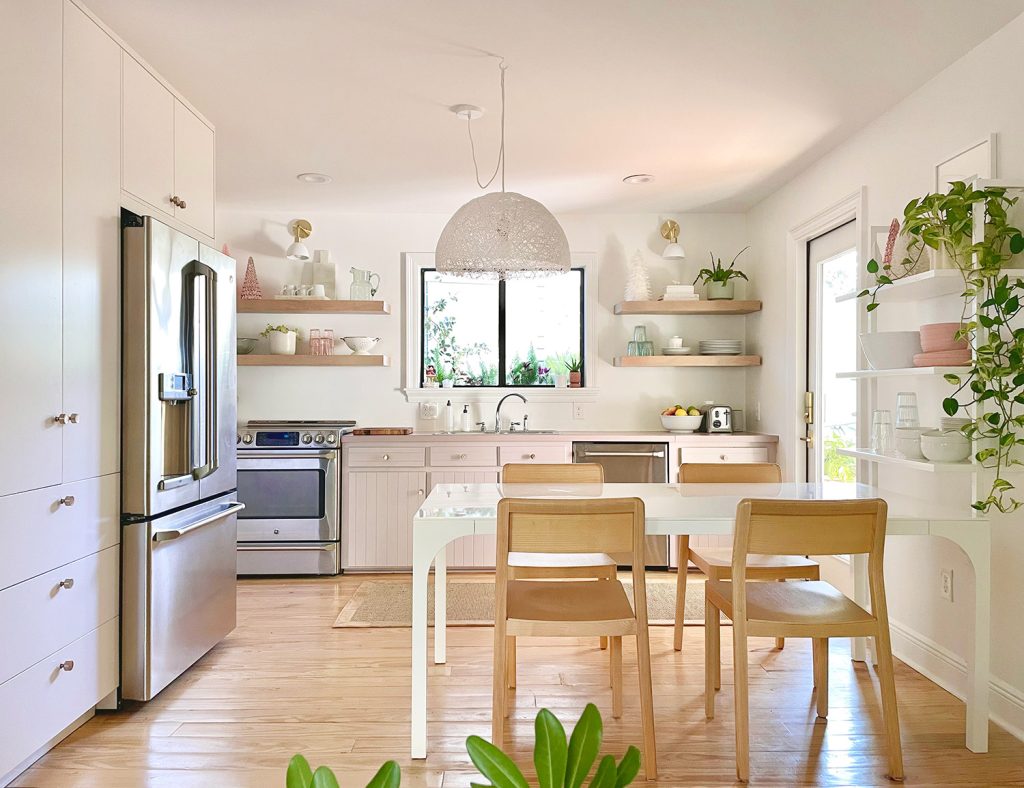
The mauve feels like a fun homage to the original laminate counters and even the walls, which we discovered were once that color during our first phase of renovations before we moved in.
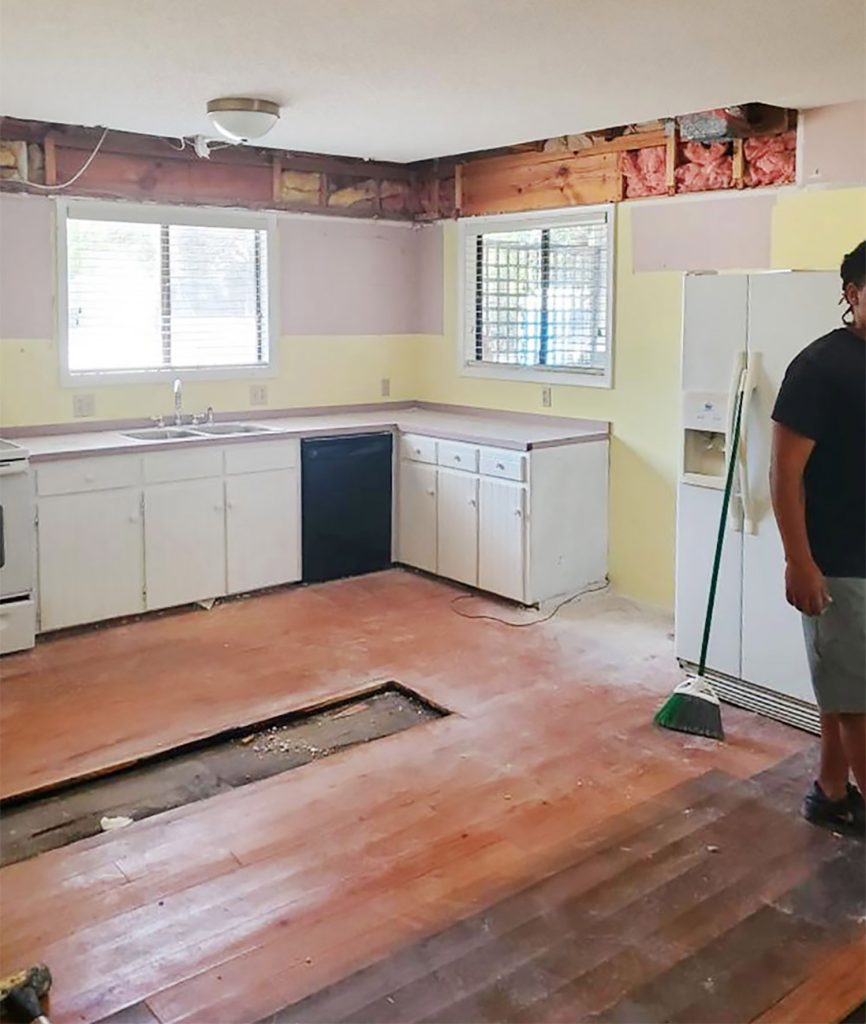
Ikea doesn’t sell any doors that color and ordering paintable Semihandmade doors is significantly more expensive. Their DIY flat slab fronts would’ve cost us about $600 vs the $185 we’d pay for white flat fronts from Ikea. And we are no strangers to painting something, so it felt worth attempting this, even though laminate surfaces or slick pre-painted finishes (Ikea calls these “lacquered”) can be a little tricky. Thankfully, paint and primer “technology” is constantly improving and you can now get strong bonds, even without turning to oil-based products. So here’s exactly what we used:
Tools & Materials For Painting Ikea Cabinets
We took a low-tech, low-mess approach to this project (aka: no paint sprayer) so the material list is pretty simple. Had we been painting a larger kitchen, we might’ve opted for a faster paint sprayer approach, but I personally find that we can be more methodical and careful when we hand paint a project like this.
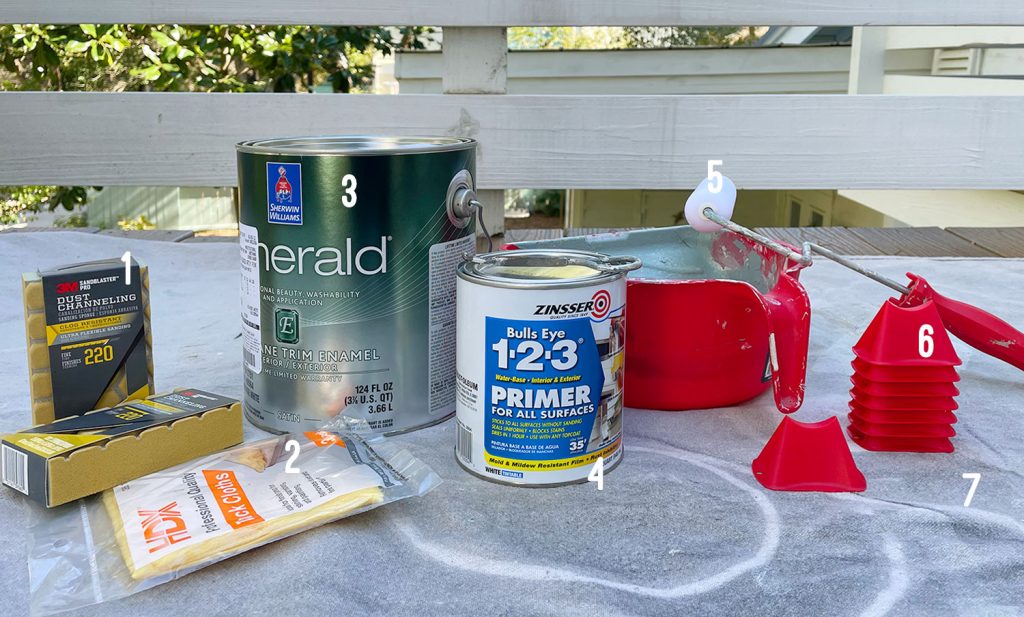
In addition to your cabinets (we ordered Ikea’s VEDDIGNE door and drawer fronts) you’ll need the following:
- Sandpaper or sanding block in a 120 to 220 grit*
- Tack cloths
- Paint (we used Sherwin-Williams Emerald Urethane Trim Enamel in a satin finish)
- Primer (we used Zinsser Bulls Eye 1-2-3 Primer for All Surfaces – a quart was more than enough for us)
- Small 4″ or 6″ foam rollers, roller tray, and a small angled paintbrush
- Painter stands or tripods
- Dropcloth or similar
- Your cabinet fronts, we had ordered Ikea VEDDIGNE doors
- Optional: Painter’s tape
- Optional: Liquid deglosser
*You can also use an electric sander for a faster result, but it takes some extra care that we’ll talk about in a moment
How To Paint Ikea Cabinets: A Quick Video!
If you want the quick & dirty version of this process, I had fun with this two-minute video that covers each step in a Gen Z-friendly, transition-tastic way. You won’t catch me on TikTok or making IG Reels, but I like an editing project (I was the kid in middle school making all sorts of videos with star wipes and other “fancy” effects). For the more detailed scoop, we’ve got a full written tutorial AND A MORE DETAILED VIDEO later on in the post that includes more specific tips. That one’s for all of my fellow Millennials that like to see someone talk through a project without sparing a single detail (as I’m known to do).
Note: You can also watch this video on YouTube
Step 1: Prepare Your Cabinets
Since we were painting our cabinets BEFORE assembling our kitchen, we just unboxed the doors and laid everything out on a dropcloth to get started. But if you’re painting an existing kitchen you’ll want to remove all of your doors and drawer fronts first. You’ll also probably want to take the extra step of cleaning them with a liquid deglosser to remove any cooking grease or oils that may have built up on your doors and drawers.
Step 2: Rough Them Up With Sandpaper
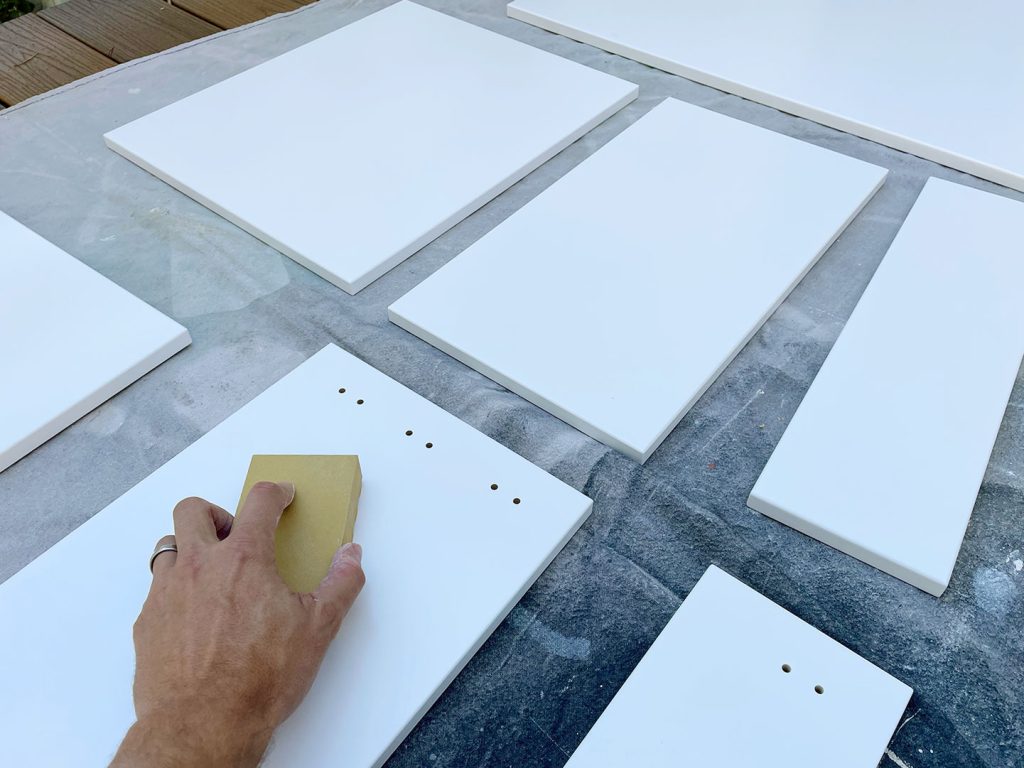
Even if you’ve used a deglosser or liquid sandpaper, it’s still a good idea to rough up the surface with actual sandpaper to create a better surface for primer and paint adherence. Prep is really the difference between painted cabinets that last and ones that look crappy within a month. So don’t skimp on the prep, my friends. Trust me.
The goal was NOT to fully remove any of the white surface since it offers moisture protection to the MDF below. So we started carefully with a fine-grit 220 sanding block and eventually worked up to 120-grit sandpaper on our battery palm sander. I filmed the how-to videos before testing out my power sander because it should be used with cautio. You can easily sand off too much if you’re not careful- especially on the edges and corners – so I didn’t trust myself to simultaneously film and sand with it. But it can speed up this step a bit.
Step 3: Fully Remove Your Sanding Dust
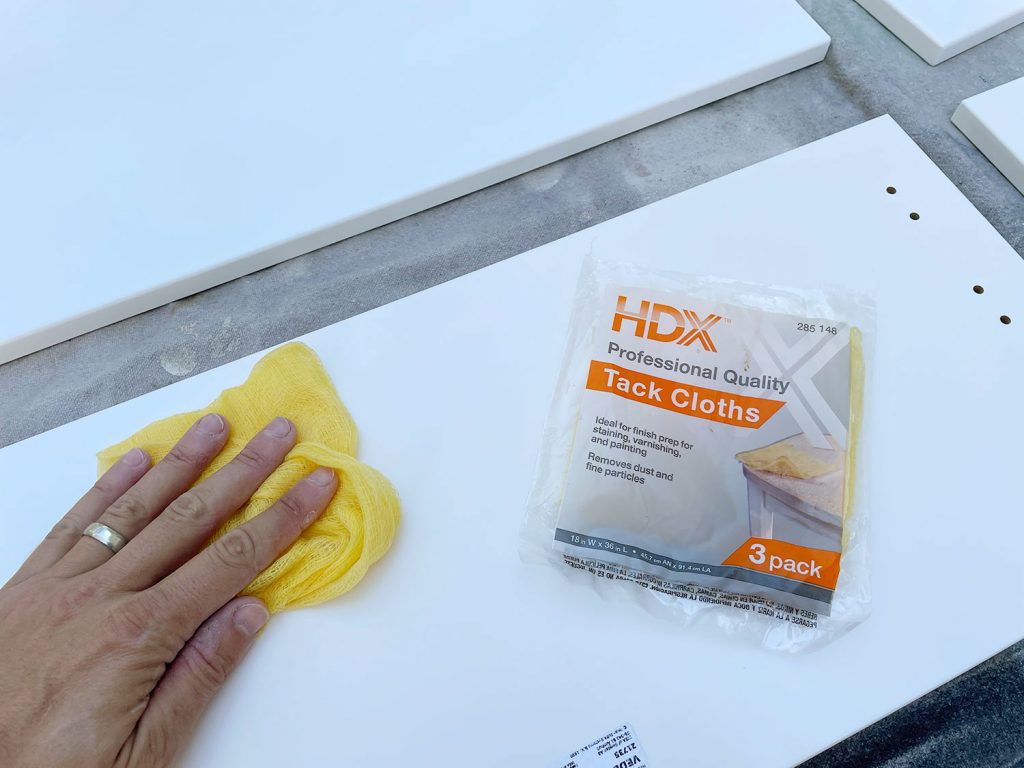
You want your primer to adhere to the door itself, not a layer of sanding dust, right? So we went over each door with a damp paper towel first, then a tack cloth. The slightly tacky surface of the cloth is great for grabbing fine particles before you paint or stain any surface. Be sure to get all sides.
Step 4: Prime the BACKS
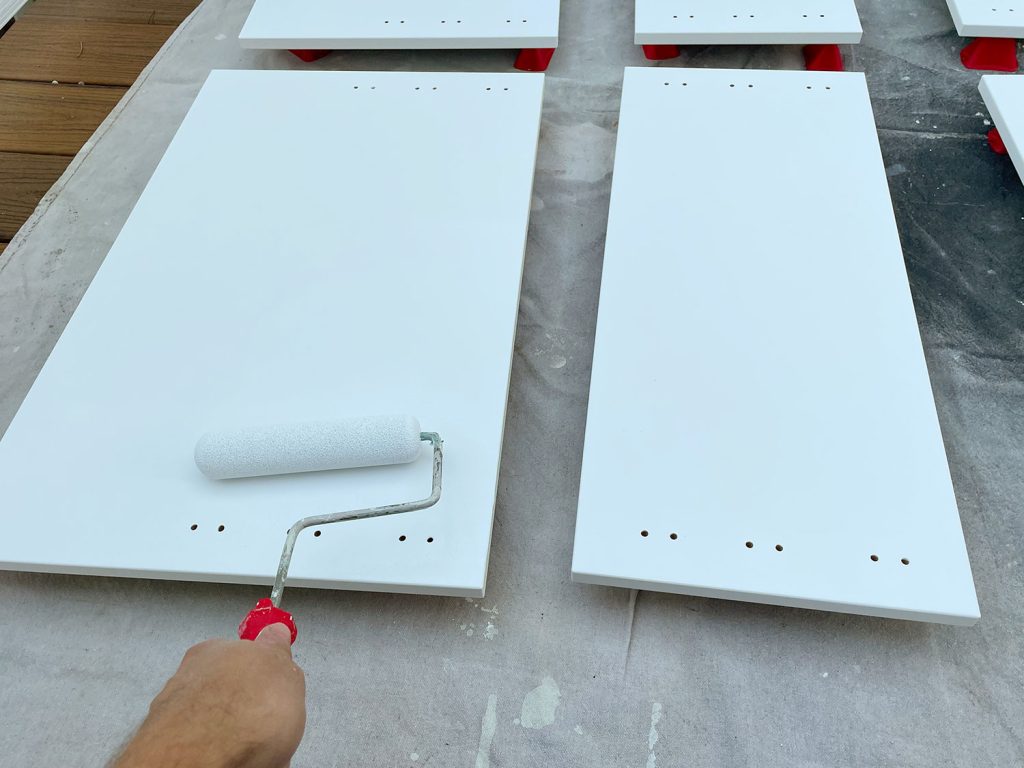
Before we started priming and painting, we propped everything up off our dropcloth with these paint project lifters. It was my first time using them, so I was a little paranoid that they might scratch or leave marks as I flipped the doors over to work on each side. So to be totally safe I decided to FULLY PRIME & PAINT THE BACKS before doing anything to the fronts. This way I’d never have to rest the painted fronts on the lifters. That way, if the lifters did leave tiny marks somewhere, it would be on the less-important backside of the drawers (fortunately they didn’t!).
Oh and as for the actual priming, we just used a small foam roller to apply a thin and even coat of Zinsser Bulls Eye 1-2-3 and let it fully dry for 4 hours before proceeding. Store your wet rollers in a Ziploc bag for later use.
Step 5: Paint The Backs

Once our primer was fully cured, we used a fresh roller to apply two thin and even coats of paint. Again, we used Sherwin-Williams Emerald Urethane Trim Enamel based on the recommendation from the paint pro at the store. We chose a Satin finish because we like that low-sheen look. If you choose a glossier finish, just be aware that roller and brush strokes can be easier to see, so you may want to use a paint sprayer instead.
Our general order for painting each door back was:
- Apply paint across the whole flat surface
- Gently roll along all 4 vertical sides to smooth out any drips (more on this in the next step)
- Roll lightly over the flat surface again, using parallel overlapping strokes in the same direction
Step 6: Repeat! Apply A Second Coat of Paint.
Don’t panic if your first coat looks imperfect like ours did below. I always recommend two coats for any project because it’ll give you a more consistent looking and stronger/more durable finish (and two thin and even coats are WAY better than one thick and gloppy one). So once your first coat has fully dried (we let ours dry overnight), roll on a second coat.
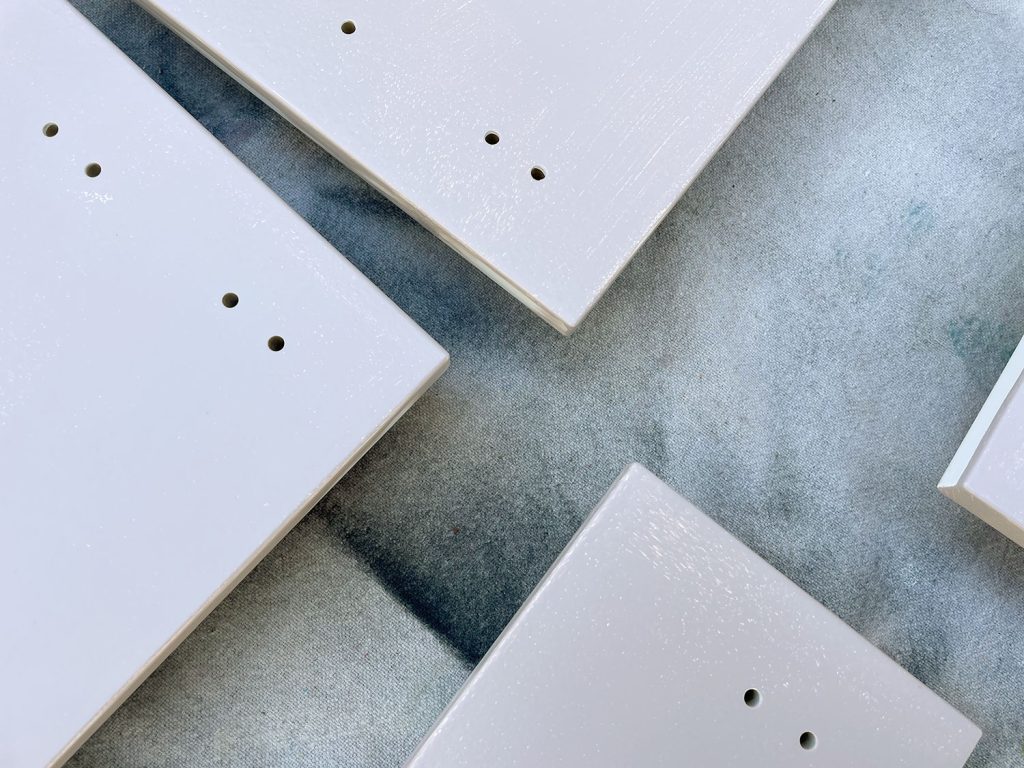
You can also see above that our coverage is spotty on the sides. That was intentional. Since we were focusing only on the BACKS, we just gently rolled the sides to smooth out any drips if they occurred. Hence that weird half-painted effect on the edges above.
Why not paint the sides completely yet? Well, if you press a roller too firmly or apply too much paint against a thin edge like this, it can cause paint to collect along the underside. That’s something you might not notice until you flip things over and, in this case, that would mean a ridge or bead of paint on the front of your cabinet. So we decided to fully paint the edges while painting the fronts, that way any errant paint build-up would be on the less-important back side (spoiler alert: we didn’t have any anyway, but better to be safe than sorry!).
Step 7: Flip Over & Repeat Steps 4, 5 + 6
We gave the cabinet backs a full 24 hours to dry and harden, and then carefully flipped everything over to begin the process again on the fronts. I know this seems tedious, but we figured it was better to be slow and methodical for the best result. Remember, we really didn’t want any dings from the paint lifters on the fronts, which we worried might happen if we were flipped them back and forth throughout the process.
So we proceed with a coat of primer on the fronts…

And then, once the primer fully dried, we painted them (you guessed it, two coats).

This time around we made sure to get the sides good and covered. Again, not using too much paint or too much pressure, but being careful to get everything well coated.
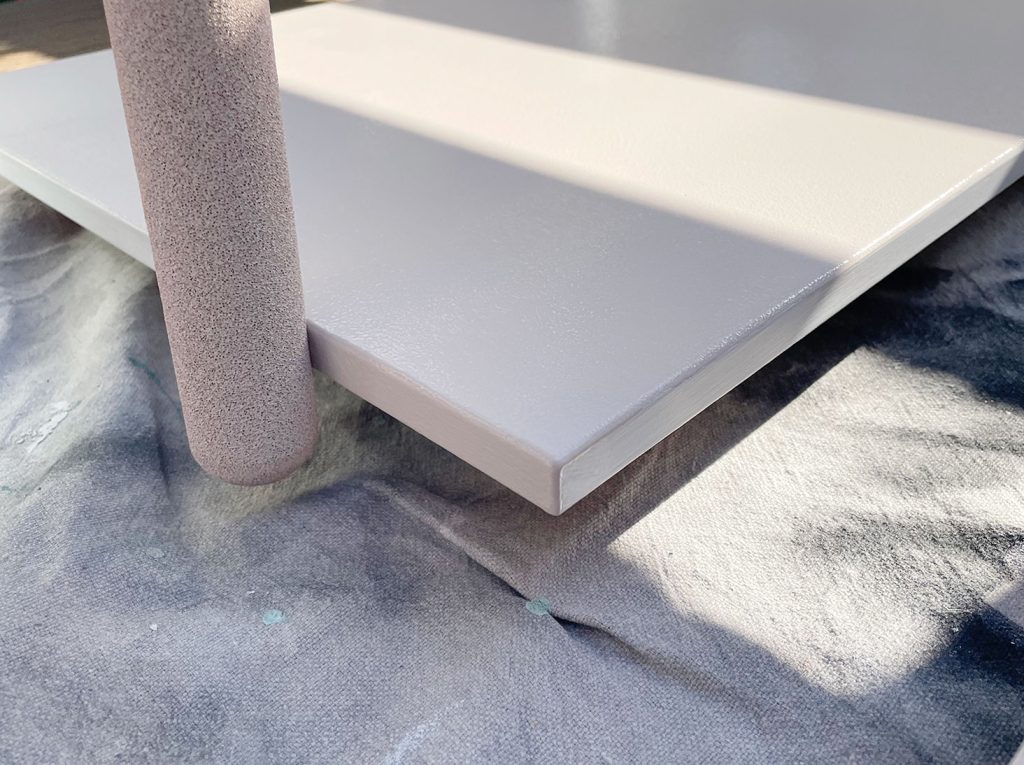
Once the second coat was done on the fronts and sides, we let things dry and cure for another full 24 hours before installing them. It honestly doesn’t hurt to wait 48 hours. Most cabinet jobs get ruined by two things: inadequate prep, or not enough curing time (literally anything can get dings or scrapes if the paint isn’t fully dry).
Step 8: Don’t Forget To Paint The Cabinet Boxes
We used the same technique to paint any visible parts of the cabinet boxes themselves as the one I detailed above. We sanded/primed/painted the filler pieces on the sides, the toe kicks, and the front of the frames (but not the insides – those we left white). Use a small foam roller for as much as you can and feel free to use painter’s tape as needed. You’ll likely need a short-handled paintbrush to edge some parts.
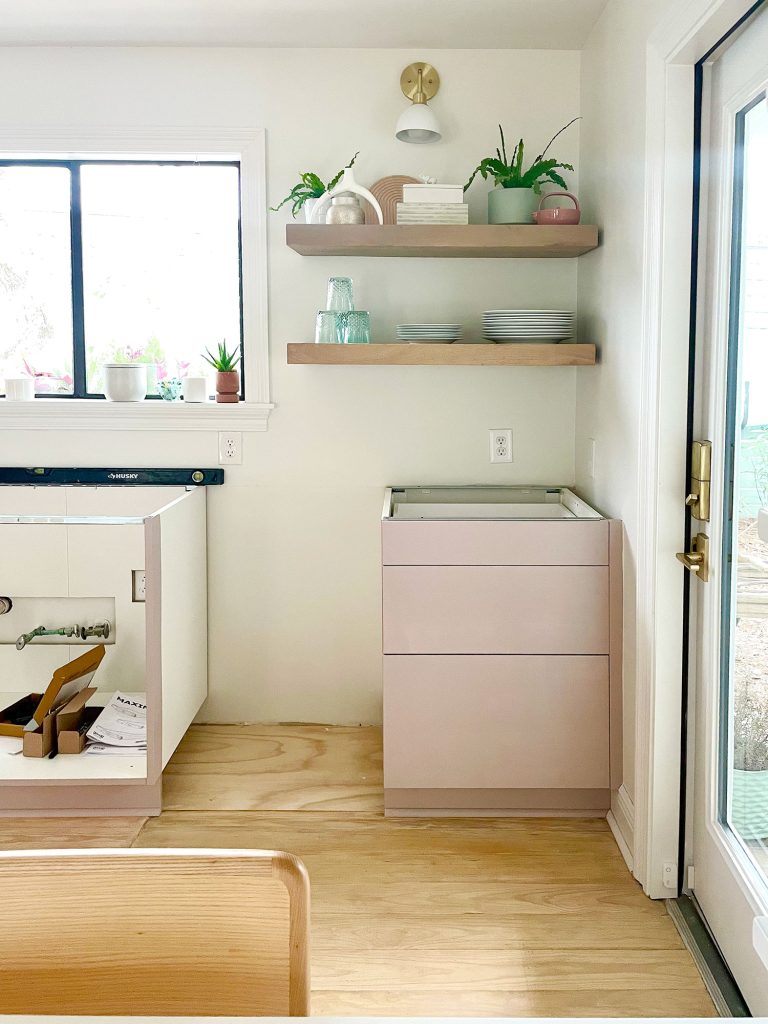
You can see that we also painted slightly around the side edge of this cabinet next to the dishwasher so we wouldn’t see any random flashes of white when the dishwasher door was open.
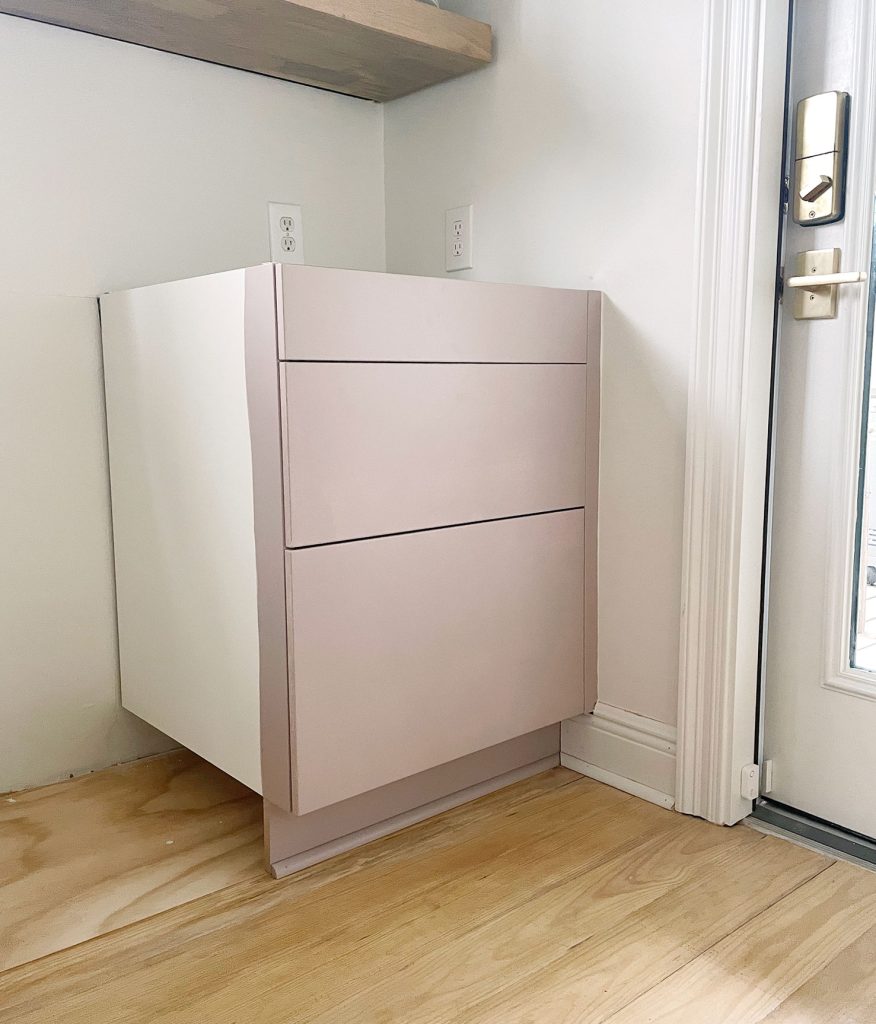
TIP: Maybe Make Your Hardware Holes Earlier?
Confession: the photos above were actually taken BEFORE we finished painting the drawer fronts. In fact if you study the sides of the drawer fronts you can see that they’re not fully covered yet.
Our counters were being templated that day and we really wanted all of the doors and drawers in place, just to be sure the templater took them into consideration when measuring for the countertop. But the weather had delayed our painting schedule, so we made the decision to install everything with only one coat of paint on the fronts (even though we’d have to uninstall the door and drawers to finish up later).
We decided to make the most of this curveball and go ahead with making our hardware holes while we had them hung for countertop templating (you can watch our cabinet hardware installation tutorial here). Turns out, we were decidedly less nervous about marking, taping, and drilling into the drawers knowing we wouldn’t be messing up the *final* paint coat on each door. If our drill slipped or plastic template scuffed something, we could cover it with our last coat.
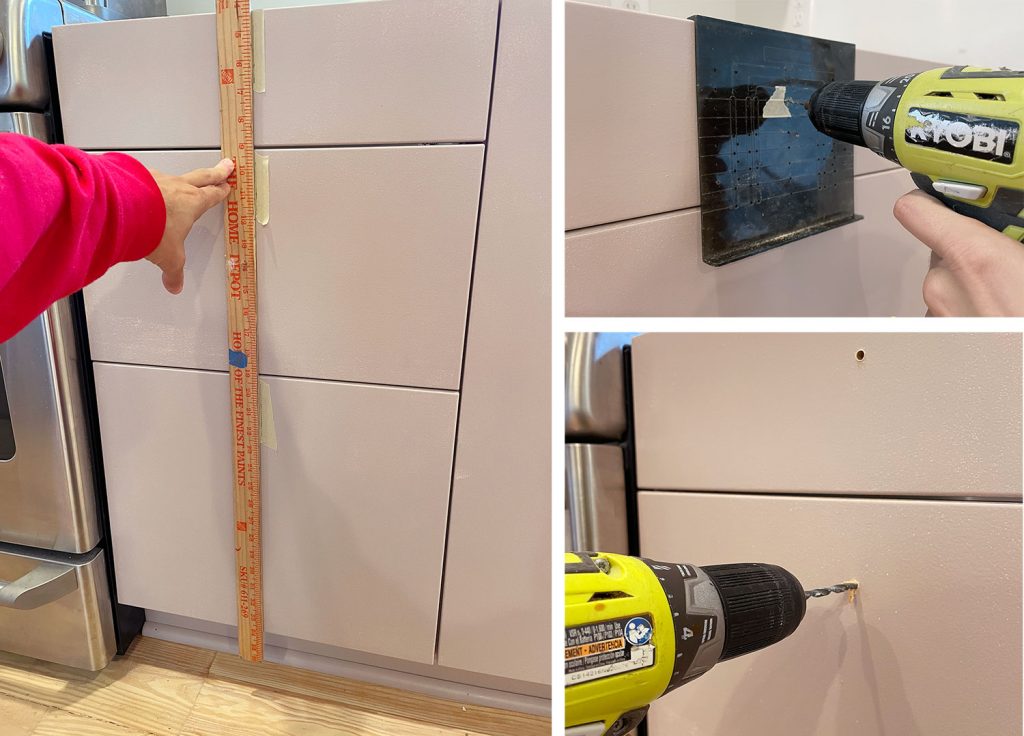
Plus, with our holes already made, we could really let that second coat cure and harden without any heavy manhandling immediately afterward, which can happen when you install the hardware.

So while it’s certainly not necessary to drill your hardware holes between your first and second coat of paint on the fronts, we found it to be a happy accident that we appreciated.
Step 9: Install Everything & Enjoy!
As delicately as we treated these painted cabinets the whole time we worked on them, they very quickly proved that they didn’t need to be handled with any special care at all. I don’t want to be too cocky since we’re only a month into using them, but so far they’ve stood up to bangs, kicks, spills, scrubbing, and lots of use. Zero issues. Again, I repeat: don’t skim on your prep and let everything not only dry but fully cure before you beat it up. That is truly the key to a good lasting finish. It meant this kitchen took about a full week to come together instead of just a day or two of quick-and-dirty painting, but it’s so worth it in the end.
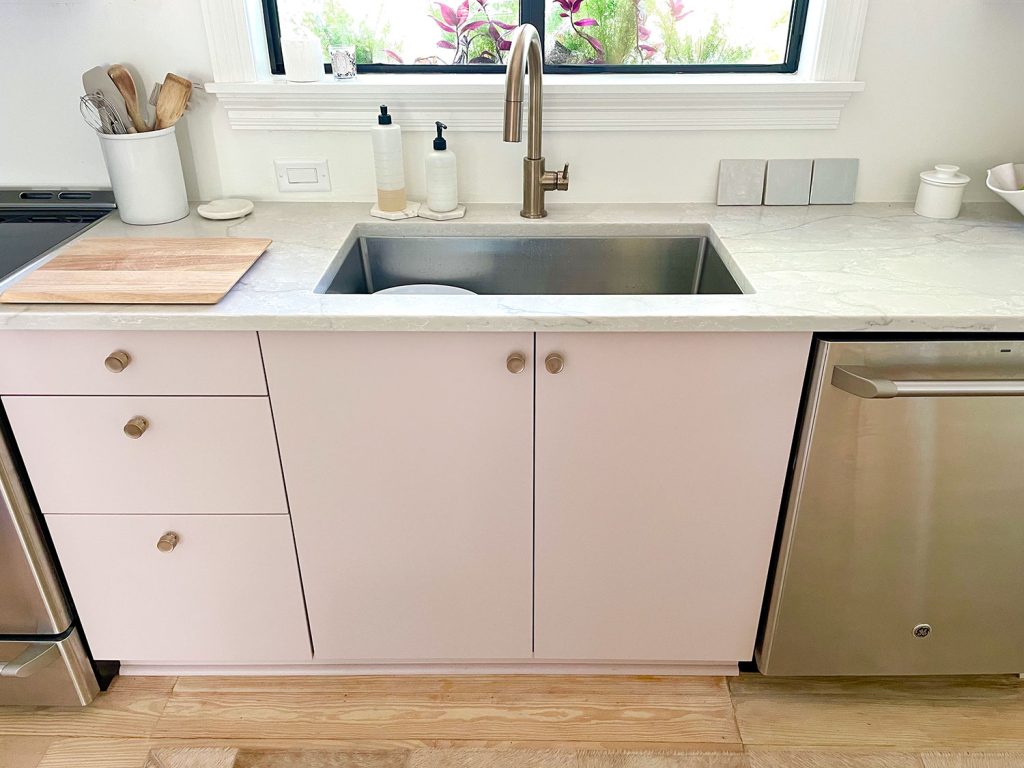
Step-By-Step Video
But before I go, as promised, here is a much more detailed and less Gen-Z-transition-heavy video that details the process of painting these cabinets. I’m glad we filmed this along the way, because sometimes a video is worth a thousand photos, and while a quick TikTok like mashup of footage makes everything look like it takes five minutes, you can really see how doable this process is in this video. It’s not fast but it’s very beginner-friendly.
Note: You can watch this video on YouTube
We’ll keep everyone posted (and will update this post) as time goes on to see how they hold up over months and years of daily use. I doubt it will be perfect, but no painted cabinets ever are anyway. The premium factory painted white cabinets in our last house had dings and scratches all around the pullout trash drawer about a year into owning them. At least with these we can fix the finish ourselves with just a fresh coat of paint!

Oh and we felt so good about how this process went that we decided to install more cabinets (hello uppers! Goodbye open shelves along that back wall! And it also means we can add a hidden vent hood over the stove!). We’re still fans of open shelving (we have that white glossy shelving system next to our kitchen table just steps away) but we think it’ll be the best of both worlds to have some upper cabinets too. And as for the process of painting them, we plan to do the exact same thing that we detailed here in this post. Stay tuned for a post full of photos when they’re done!
And if you’re interested in some other painting projects, here are a few oldies-but-goodies:
- How to paint your front door (and our favorite door paint)
- A look at our favorite neutral wall color: Edgecomb Gray
- A detailed look at painting our previous brick house white
- The best paintbrush for cutting in and painting trim
- How we painted a ceiling a little darker & glossier
- How to upgrade your old door knobs with spray paint
- How to prep, prime, and paint a brick fireplace
- How to paint dark wood trim and wood paneling
- How to whitewash a brick wall or fireplace
*This post contains affiliate links, so we may earn a small commission when you make a purchase through links on our site at no additional cost to you.
